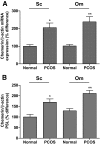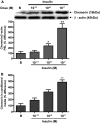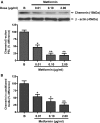Insulin and metformin regulate circulating and adipose tissue chemerin
- PMID: 19502420
- PMCID: PMC2731540
- DOI: 10.2337/db08-1528
Insulin and metformin regulate circulating and adipose tissue chemerin
Abstract
Objective: To assess chemerin levels and regulation in sera and adipose tissue from women with polycystic ovary syndrome (PCOS) and matched control subjects.
Research design and methods: Real-time RT-PCR and Western blotting were used to assess mRNA and protein expression of chemerin. Serum chemerin was measured by enzyme-linked immunosorbent assay. We investigated the in vivo effects of insulin on serum chemerin levels via a prolonged insulin-glucose infusion. Ex vivo effects of insulin, metformin, and steroid hormones on adipose tissue chemerin protein production and secretion into conditioned media were assessed by Western blotting and enzyme-linked immunosorbent assay, respectively.
Results: Serum chemerin, subcutaneous, and omental adipose tissue chemerin were significantly higher in women with PCOS (n = 14; P < 0.05, P < 0.01). Hyperinsulinemic induction in human subjects significantly increased serum chemerin levels (n = 6; P < 0.05, P < 0.01). In adipose tissue explants, insulin significantly increased (n = 6; P < 0.05, P < 0.01) whereas metformin significantly decreased (n = 6; P < 0.05, P < 0.01) chemerin protein production and secretion into conditioned media, respectively. After 6 months of metformin treatment, there was a significant decrease in serum chemerin (n = 21; P < 0.01). Importantly, changes in homeostasis model assessment-insulin resistance were predictive of changes in serum chemerin (P = 0.046).
Conclusions: Serum and adipose tissue chemerin levels are increased in women with PCOS and are upregulated by insulin. Metformin treatment decreases serum chemerin in these women.
Figures




References
-
- Dunaif A: Insulin resistance and the polycystic ovary syndrome: mechanism and implications for pathogenesis. Endocr Rev 1997; 18: 774– 800 - PubMed
-
- Wild RA, Painter RD, Coulson PB, Carruth KB, Ranney RB: Lipoprotein lipid concentrations and cardiovascular risk in women with polycystic ovary syndrome. J Clin Endocrinol Metab 1985; 61: 946– 951 - PubMed
-
- Diamanti-Kandarakis E: Insulin resistance in PCOS. Endocrine 2006; 30: 13– 17 - PubMed
-
- Kershaw EE, Flier JS: Adipose tissue as an endocrine organ. J Clin Endocrinol Metab 2004; 89: 2548– 2556 - PubMed
-
- Wajchenberg BL: Subcutaneous and visceral adipose tissue: their relation to the metabolic syndrome. Endocr Rev 2000; 21: 697– 738 - PubMed
Publication types
MeSH terms
Substances
LinkOut - more resources
Full Text Sources
Medical

